iOS蓝牙BLE4.0通信功能
概述
详细
一、蓝牙常见名称和缩写
BLE:(Bluetooth low energy)蓝牙4.0设备因为低耗电
BLE:(Bluetooth low energy)蓝牙4.0设备因为低耗电
Central:中心设备,发起蓝牙连接的设备(一般是指手机)
Peripheral:外设,被蓝牙连接的设备(一般是运动手环)
Service and Characteristic:服务和特征,每个设备会提供服务和特征,类似于服务端的API,但是结构不同,每个设备会有很多服务,每个服务中包含很多特征,这些特征的权限一般分为读(read),写(write),通知(notify)几种,就是我们连接设备后具体需要操作的内容
Description:描述,每个Characteristic可以对应一个或者多个Description用于描述Characteristic的信息或属性
二、蓝牙基础知识
1、CoreBluetooth框架的核心其实是俩东西
Peripheral
Central
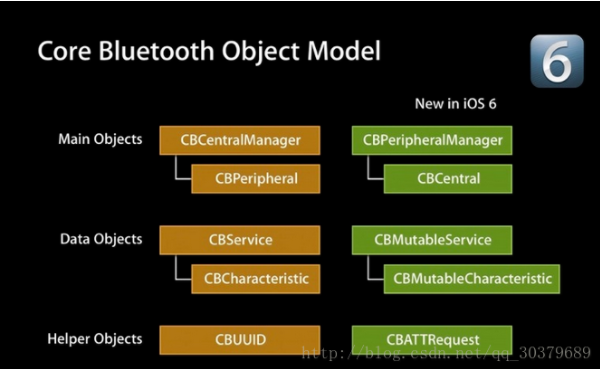
2、这两组api分别对应不同的业务常见
左侧叫中心模式,就是以你的app作为中心,连接其他的外设的场景
右侧称为外设模式,使用外设连接其他中心设备操作的场景
3、服务和特征(service and characteristic)
每个设备都会有1个or多个服务
每个服务里都会有1个or多个特征
特征就是具体键值对,提供数据的地方
每个特征属性分为:读,写,通知等等
外设,服务,特征的关系
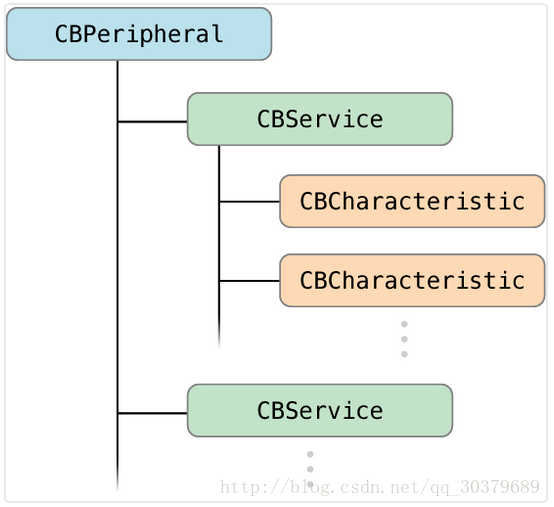
三、BLE中心模式流程
1、建立中心角色
2、扫描外设(Discover Peripheral)
3、连接外设(Connect Peripheral)
4、扫描外设中的服务和特征(Discover Services And Characteristics)
4.1 获取外设的services
4.2 获取外设的Characteristics,获取characteristics的值
4.3 获取Characteristics的Descriptor和Descriptor的值
5、利用特征与外设做数据交互
6、订阅Characteristic的通知
7、断开连接(Disconnect)
四、准备工作
1、一台苹果设备,进行真机测试
2、一个蓝牙模块或者外设
五、程序实现
项目代码截图:
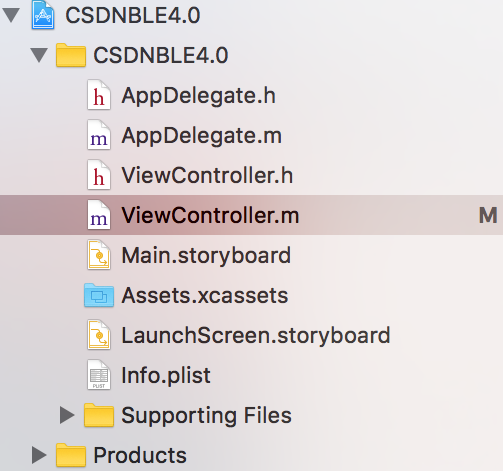
以下是实现的过程:
1、导入依赖库、声明委托、定义变量
#import "ViewController.h" #import <CoreBluetooth/CoreBluetooth.h> #define mBLEName @"ZJ2" @interface ViewController () <CBCentralManagerDelegate, CBPeripheralDelegate> //手机设备 @property (nonatomic, strong) CBCentralManager *mCentral; //外设设备 @property (nonatomic, strong) CBPeripheral *mPeripheral; //特征值 @property (nonatomic, strong) CBCharacteristic *mCharacteristic; //服务 @property (nonatomic, strong) CBService *mService; //描述 @property (nonatomic, strong) CBDescriptor *mDescriptor; @end
2、程序开始时初始化设备
- (CBCentralManager *)mCentral
{
if (!_mCentral) {
_mCentral = [[CBCentralManager alloc] initWithDelegate:self
queue:dispatch_get_main_queue()
options:nil];
}
return _mCentral;
}
- (void)viewDidLoad
{
[super viewDidLoad];
//中心管理者初始化
[self mCentral];
}3、当程序退出时,记得断开连接
- (void)viewDidDisappear:(BOOL)animated
{
[super viewDidDisappear:animated];
// 停止扫描
if([self.mCentral isScanning]){
NSLog(@"stopScan");
[self.mCentral stopScan];
}
//停止连接
if(nil != self.mPeripheral && self.mPeripheral.state == CBPeripheralStateConnecting){
NSLog(@"cancelPeripheralConnection");
[self.mCentral cancelPeripheralConnection:self.mPeripheral];
}
}4、扫描外设
//只要中心管理者初始化,就会触发此代理方法
- (void)centralManagerDidUpdateState:(CBCentralManager *)central
{
switch (central.state) {
case CBManagerStateUnknown:
NSLog(@"CBManagerStateUnknown");
break;
case CBManagerStateResetting:
NSLog(@"CBManagerStateResetting");
break;
case CBManagerStateUnsupported:
NSLog(@"CBManagerStateUnsupported");
break;
case CBManagerStateUnauthorized:
NSLog(@"CBManagerStateUnauthorized");
break;
case CBManagerStatePoweredOff:
NSLog(@"CBManagerStatePoweredOff");
break;
case CBManagerStatePoweredOn:
{
NSLog(@"CBManagerStatePoweredOn");
//搜索外设
[self.mCentral scanForPeripheralsWithServices:nil // 通过某些服务筛选外设
options:nil]; // dict,条件
}
break;
default:
break;
}
}5、连接外设
//发现外设后调用的方法
- (void)centralManager:(CBCentralManager *)central // 中心管理者
didDiscoverPeripheral:(CBPeripheral *)peripheral // 外设
advertisementData:(NSDictionary *)advertisementData // 外设携带的数据
RSSI:(NSNumber *)RSSI // 外设发出的蓝牙信号强度
{
NSLog(@"搜索到设备名:%@,设备ID:%@",peripheral.name,peripheral.identifier);
//(ABS(RSSI.integerValue) > 35)
//发现完之后就是进行连接
if([peripheral.name isEqualToString:mBLEName]){
self.mPeripheral = peripheral;
self.mPeripheral.delegate = self;
[self.mCentral connectPeripheral:peripheral options:nil];
}
}6、获取服务
//中心管理者连接外设成功
- (void)centralManager:(CBCentralManager *)central // 中心管理者
didConnectPeripheral:(CBPeripheral *)peripheral // 外设
{
NSLog(@"设备连接成功,设备名:%@", peripheral.name);
//7、外设发现服务,传nil代表不过滤
[self.mPeripheral discoverServices:nil];
}
// 外设连接失败
- (void)centralManager:(CBCentralManager *)central didFailToConnectPeripheral:(CBPeripheral *)peripheral error:(NSError *)error
{
NSLog(@"设备连接失败,设备名:%@", peripheral.name);
}
// 丢失连接
- (void)centralManager:(CBCentralManager *)central didDisconnectPeripheral:(CBPeripheral *)peripheral error:(NSError *)error
{
NSLog(@"设备丢失连接,设备名:%@", peripheral.name);
}7、获取服务中的特征
//发现外设的服务后调用的方法
- (void)peripheral:(CBPeripheral *)peripheral didDiscoverServices:(NSError *)error
{
// 是否获取失败
if (error) {
NSLog(@"设备获取服务失败,设备名:%@", peripheral.name);
return;
}
for (CBService *service in peripheral.services) {
self.mService = service;
NSLog(@"设备获取服务成功,服务名:%@,服务UUID:%@,服务数量:%lu",service,service.UUID,peripheral.services.count);
//外设发现特征
[peripheral discoverCharacteristics:nil forService:service];
}
}8、获取特征中的值和描述
//从服务中发现外设特征的时候调用的代理方法
- (void)peripheral:(CBPeripheral *)peripheral didDiscoverCharacteristicsForService:(CBService *)service error:(NSError *)error
{
if(error){
NSLog(@"设备获取特征失败,设备名:%@", peripheral.name);
return;
}
/**
CBCharacteristicPropertyRead = 0x02,
CBCharacteristicPropertyWriteWithoutResponse = 0x04,
CBCharacteristicPropertyWrite = 0x08,
CBCharacteristicPropertyNotify = 0x10,
*/
for (CBCharacteristic *cha in service.characteristics) {
if(cha.properties & CBCharacteristicPropertyWrite){
NSLog(@"CBCharacteristicPropertyWrite");
NSLog(@"%lu",cha.properties & CBCharacteristicPropertyWrite);
self.mCharacteristic = cha;
}else if(cha.properties & CBCharacteristicPropertyWriteWithoutResponse){
NSLog(@"CBCharacteristicPropertyWriteWithoutResponse");
}else if(cha.properties & CBCharacteristicPropertyRead){
NSLog(@"CBCharacteristicPropertyRead");
}else if(cha.properties & CBCharacteristicPropertyNotify){
NSLog(@"CBCharacteristicPropertyNotify");
}else if(cha.properties & CBCharacteristicPropertyIndicate){
NSLog(@"CBCharacteristicPropertyIndicate");
}
NSLog(@"设备获取特征成功,服务名:%@,特征值名:%@,特征UUID:%@,特征数量:%lu",service,cha,cha.UUID,service.characteristics.count);
//获取特征对应的描述 会回调didDiscoverDescriptorsForCharacteristic
[peripheral discoverDescriptorsForCharacteristic:cha];
//获取特征的值 会回调didUpdateValueForCharacteristic
[peripheral readValueForCharacteristic:cha];
}
if(nil != self.mCharacteristic){
//打开外设的通知,否则无法接受数据
[peripheral setNotifyValue:YES forCharacteristic:self.mCharacteristic];
}
}9、读取特征中的值和描述
//更新特征值的时候调用,可以理解为获取蓝牙发回的数据
- (void)peripheral:(CBPeripheral *)peripheral didUpdateValueForCharacteristic:(CBCharacteristic *)characteristic error:(NSError *)error
{
NSString *value = [[NSString alloc] initWithData:characteristic.value encoding:NSASCIIStringEncoding];
NSLog(@"特征名:%@,特征值:%@",characteristic,value);
if([value isEqualToString:@"open"]){
}else if([value isEqualToString:@"close"]){
}
}10、状态改变和发现描述
//通知状态改变时调用
-(void)peripheral:(CBPeripheral *)peripheral didUpdateNotificationStateForCharacteristic:(CBCharacteristic *)characteristic error:(NSError *)error{
if(error){
NSLog(@"特征名:%@,改变通知状态失败",characteristic);
}
NSLog(@"特征名:%@,改变了通知状态",characteristic);
}
//发现外设的特征的描述数组
- (void)peripheral:(CBPeripheral *)peripheral didDiscoverDescriptorsForCharacteristic:(nonnull CBCharacteristic *)characteristic error:(nullable NSError *)error
{
if(error){
NSLog(@"设备获取描述失败,设备名:%@", peripheral.name);
return;
}
for (CBDescriptor *descriptor in characteristic.descriptors) {
self.mDescriptor = descriptor;
[peripheral readValueForDescriptor:descriptor];
NSLog(@"设备获取描述成功,描述名:%@",descriptor);
}
}11、发送数据
//发送数据
-(void)sendDataToBLE:(NSString *)data{
NSData* myData = [data dataUsingEncoding:NSUTF8StringEncoding];
[self.mPeripheral writeValue:myData // 写入的数据
forCharacteristic:self.mCharacteristic // 写给哪个特征
type:CBCharacteristicWriteWithResponse];// 通过此响应记录是否成功写入
}
-(void)peripheral:(CBPeripheral *)peripheral didWriteValueForCharacteristic:(CBCharacteristic *)characteristic error:(NSError *)error{
NSLog(@"数据发送成功");
}六、运行效果
从电脑串口助手可以看到,发送了两次的D3数据,手机也收到了两次11的数据
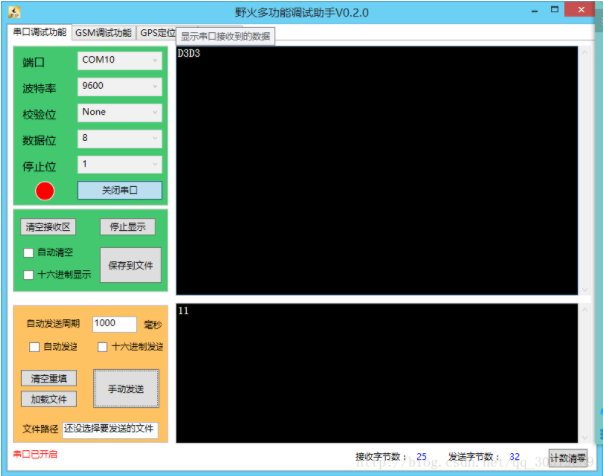
这里使用的是蓝牙模块Risym cc2541和苹果手机实现两者的通信功能,根据BLE中心模式流程走就可以了
下面是手机设备NSLog打印输出的结果,从连接到发送数据和接收数据的过程。
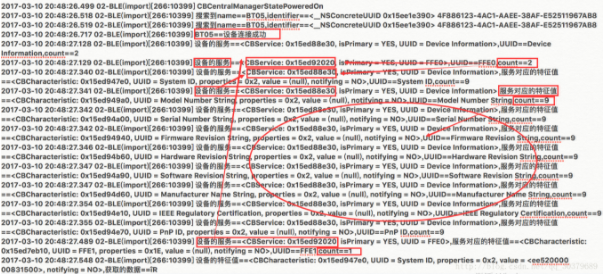
(查看大图)
可以发现连接成功后,设备有两个服务,第一个服务对应有九个特征值,第二个服务对应有一个特征值,验证了上面的原理是正确的
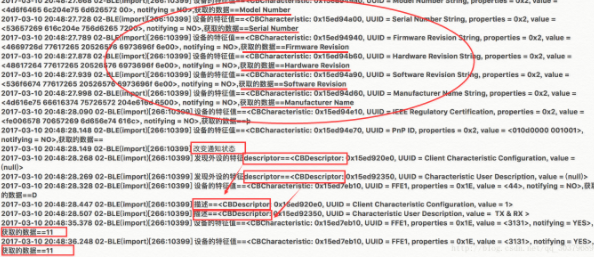
(查看大图)
七、其他补充
CSDN博客地址:http://blog.csdn.net/qq_30379689/article/details/61413950
CSDN课程地址:http://edu.csdn.net/course/detail/4534





